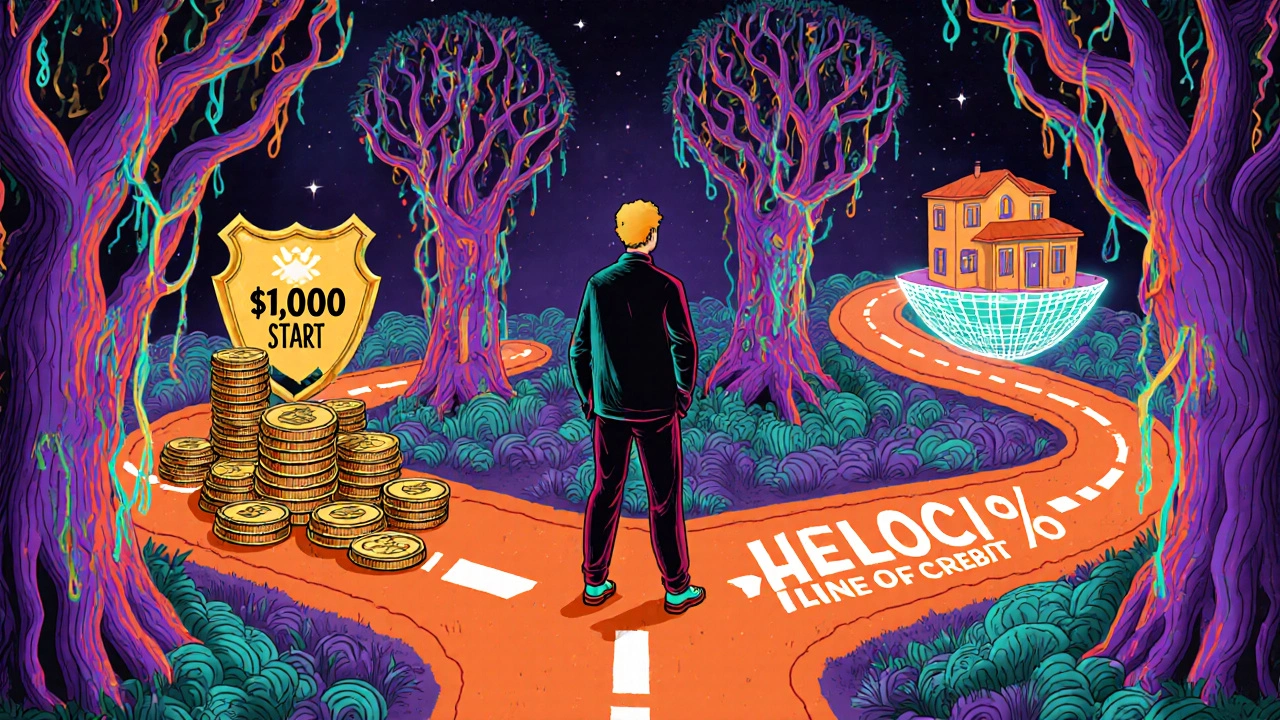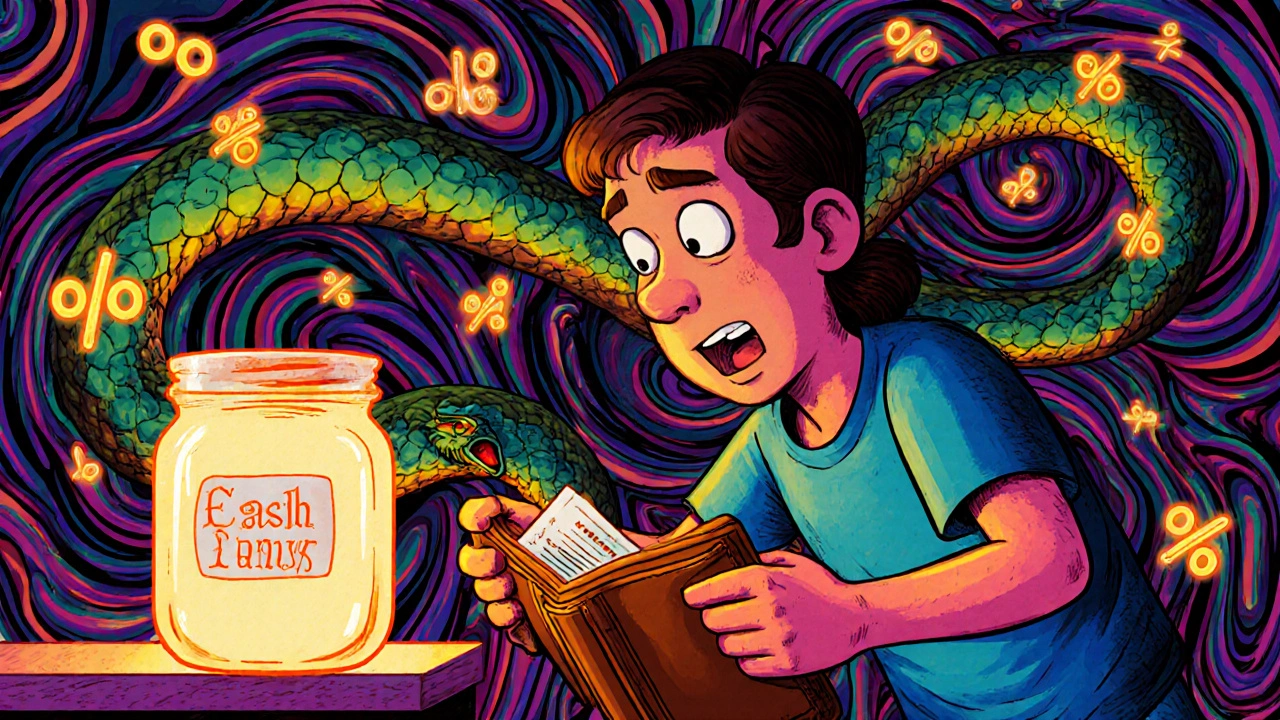Emergency Fund vs Line of Credit Calculator
Compare costs of using cash savings versus borrowing for unexpected expenses
Imagine your car breaks down. The mechanic says $800 to fix it. You reach for your wallet. No cash. No credit card. Just panic. That’s the moment an emergency fund or a line of credit becomes more than a financial term-it becomes your lifeline.
Most people think they have to choose: either save up cash or rely on credit. But the real question isn’t which one is better. It’s which one works for you right now-and how you can use both without shooting yourself in the foot.
What Exactly Is an Emergency Fund?
An emergency fund is cash you keep separate from your regular checking account. It’s not for vacations. Not for new shoes. Not even for that surprise birthday party. It’s for when your water heater bursts, your dog needs emergency surgery, or you lose your job. This money sits in a savings account, money market account, or short-term CD-anywhere it’s safe, liquid, and easy to grab.
The standard advice? Save three to six months of essential living costs. That means rent or mortgage, groceries, gas to get to work, insurance premiums, and basic medical needs. Not your Netflix subscription. Not your gym membership. Just the stuff that keeps you alive and employed.
According to the Consumer Financial Protection Bureau, single-earner households should aim for 3.7 months’ worth. Dual-earner households? 5.2 months. Why the difference? More income streams mean more stability-but also more expenses to cover if one person loses their job.
Here’s the hard truth: only 61% of U.S. adults could cover a $400 emergency with cash. That’s not a typo. That’s the Federal Reserve’s 2022 data. So if you’ve got $1,000 saved, you’re already ahead of most people.
What’s a Line of Credit, Really?
A line of credit is a bank’s promise to lend you money-up to a limit-when you need it. You don’t get the cash upfront. You borrow only what you use, and you pay interest only on what you take out. The two most common types? Personal lines of credit and Home Equity Lines of Credit (HELOCs).
HELOCs use your home as collateral. That means if you can’t pay, you risk losing your house. But they usually come with lower interest rates-around 8.5% as of late 2023-compared to credit cards, which average over 22%. Personal lines of credit don’t need collateral, but they’re harder to qualify for and often carry higher rates.
Unlike an emergency fund, a line of credit isn’t free money. It’s debt. And debt has strings: credit checks, approval times (3-7 business days), and the risk that your lender can cut your limit during a crisis. During the pandemic, 23% of HELOC users had their credit lines reduced or frozen when they needed them most.
When to Use Your Emergency Fund
Use your emergency fund for small, sudden, unavoidable costs. Think:
- Car repairs ($500 average, AAA 2023)
- Prescription co-pays or urgent vet visits ($1,200 median, Kaiser Family Foundation)
- Minor home fixes like a broken furnace or leaking roof ($1,500 or less)
- A week or two of lost income while waiting for unemployment to kick in
Why cash? Because there’s no interest. No application. No waiting. If your emergency fund has $2,000 and you spend $800 on a tire and alignment, you still have $1,200 left. No one asks you to justify it. No credit score gets checked. You don’t owe anything extra.
One Reddit user, BudgetSavvy27, lost their job in August 2023. Their $5,000 emergency fund covered 2.3 months of expenses while they searched for a new role. They avoided $3,800 in credit card debt that would’ve cost $456 in interest at 12% APR. That’s not luck. That’s strategy.

When a Line of Credit Makes Sense
Lines of credit shine when the emergency is too big for your savings. Think:
- A new roof ($15,000 average, HomeAdvisor)
- Major home renovation after a fire or flood
- Medical bills after a serious accident
- Legal fees from an unexpected lawsuit
Let’s say you need $15,000 for a new HVAC system. If you use your emergency fund, you’re wiped out. If you use a credit card at 22% APR, you’ll pay over $22,800 total over 10 years. But if you tap a HELOC at 8%, your total cost drops to $6,750 in interest over the same period.
HELOCHero, another Reddit user, used their $75,000 HELOC to cover a $28,000 roof replacement. They paid $1,980 in interest over 24 months. On a credit card? $5,600. That’s a $3,620 difference. That’s a new laptop. A family vacation. A down payment on a used car.
Why You Should Have Both
Here’s what most financial advice misses: you don’t have to pick one. The best strategy? Build a solid emergency fund and keep a line of credit as backup.
Bankrate’s 2023 survey found that 78% of financial advisors now recommend this dual approach. That’s up from 62% in 2018. Why the shift? Because life doesn’t come with warning labels.
Start with $1,000 in your emergency fund. That’s the bare minimum to avoid credit card panic. UMB Bank says you can save that by putting away $84 a month. Then, aim for three months’ expenses. While you’re saving, apply for a personal line of credit or HELOC if you own a home. Don’t wait until you need it.
Why? Because lenders tighten rules during crises. If you’re unemployed and suddenly need cash, your credit score might drop. Your income looks risky. You’ll get denied. But if you already have a $20,000 line of credit approved and ready, you’ve got breathing room.

What to Avoid
Don’t use your emergency fund like a checking account. That’s how people end up with $0 when a real emergency hits.
Don’t treat your line of credit like free money. If you borrow $10,000 and don’t pay it down, you’re trading one problem for another. You’ll be paying interest for years.
Watch out for hidden traps:
- Some HELOCs require you to withdraw money right away. Don’t do it. You don’t need debt just to have access.
- 37% of HELOC agreements let lenders freeze your line if you don’t use it for 12 months. Ask your bank about this before signing.
- Regulation D used to limit savings account withdrawals to six per month. It was paused during the pandemic but reinstated in 2021. Check with your bank-some still enforce it.
New Tools Are Changing the Game
Financial products are evolving. Alliant Credit Union launched an “Emergency Savings Line of Credit” in May 2023. It automatically transfers money from your savings to your checking account if your balance drops below $500. You only pay 9.9% APR on what you use. No application. No credit check. It’s like having a safety net that activates itself.
Marcus by Goldman Sachs now offers 4.50% APY on savings accounts up to $15,000-with no minimum balance. That means your emergency fund can actually grow, even in a high-interest environment.
The Consumer Financial Protection Bureau is even proposing tax-advantaged emergency savings accounts tied to retirement plans. If approved, this could make it easier for low-income households to build savings without sacrificing future security.
What’s the Bottom Line?
Emergency funds are your first line of defense. They’re simple, zero-interest, and stress-free. Lines of credit are your second line. They’re flexible, scalable, and cheaper than credit cards-but they come with risk.
If you’re starting from zero: save $1,000 first. Then build to three months’ expenses. At the same time, if you own a home, consider a HELOC. If you don’t, get a personal line of credit with a low rate and no annual fee.
Don’t wait for disaster to strike. Build your safety net before you need it. Because when the car dies, the furnace breaks, or the job disappears, you won’t want to be choosing between your credit score and your peace of mind.
